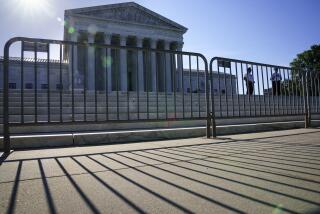Court’s Shift on Rights Requires Congress to Act
This past term the U.S. Supreme Court decided several cases that, for the first time since Reconstruction, make the elusive goals of equality and justice harder for minorities, women and the elderly to attain.
When read individually, these opinions appear to turn on what President Bush has described as “technical legal issues.”But when read together, these decisions show a systematic tilt against civil-rights claims.
The court’s historic shift is reflected in three aspects of the cases decided: It interpreted statutes expressly designed to expand remedies for civil-rights violations as having the effect of limiting the rights already available under existing law; it misinterpreted legislative history to give civil-rights statutes the narrowest reach possible, and it showed a preference for civil-rights claims by white men.
The court’s inclination to read later statutes as limiting rights under pre-existing law was starkly presented in a case involving an important 19th-Century civil- rights regulation known as Section 1981. The law at issue “prohibits racial discrimination in the making and enforcement of private contracts” and has proved a powerful tool for combatting job-related race discrimination. Yet the court has now held that while this law prohibits racial discrimination in hiring, it does not protect employees once they are on board. This leaves no effective federal remedy for on-the-job racial harassment. Ironically, the court justified this cramped interpretation in part by treating the historic Civil Rights Act of 1964 as intending to limit, rather than expand, civil rights.
In two other recent cases, the court employed similar reasoning to shield government institutions or employees from liability in cases of racial discrimination. These decisions involved a second Reconstruction-era statute, known as Section 1983, which allowed suits against any person who, under cover of state law, deprived another of constitutional rights. In the first ruling, the court held that states and state officials acting in their official capacities were not covered by this statute at all; only local governments could be hld accountable because any other interpretation would be “awkward.”
Only a week later, the same five justices held that Congress really intended Section 1983 to be the exclusive federal remedy for civil-rights violations by municipalities. According to the court, Section 1983 eliminated the cause of action against municipalities for racial discrimination in contracting provided under Section 1981. Once again, the court has read civil-rights statutes collectively as providing less protection than each law would offer independently.
The court has also been willing to ignore clear statutory language and legislative history to foster its parsimonious approach to the recognition of civil rights. For instance, it held that the Age Discrimination in Employment Act provides almost no protections for the elderly against plainly discriminatory employee-benefit plans. The court reached this conclusion even though Congress had amended the law with the specific aim of overturning a previous court decision that narrowly construed the act to be inapplicable to mandatory retirement plans.
Still, the court insisted that Congress’ true intent was to allow age discrimination in benefit plans whether or not the unfairness could be justified as “cost effective,” or even, as the dissenting justices pointed out, if the plan was founded on “abject hostility to, or . . . unfounded stereotypes” of older workers.
At the same time, the court created opportunities for one segment of society--white men--to re-litigate matters already resolved. Contrary to standard practice, the court gave unlimited time to white firefighteres to initiate an attack on a settlement entered into as a result of a discrimination suit brought by black firefighters.
This decision was reached despite the fact that the white firefighters had knowingly decided not to participate in the original litigation.
On the same day the court decided a case involving women employees who were also attacking a discriminatory seniority system. There the court threw the suit out for being brought too late, even as it acknowledged that the discriminatory nature of the seniority system could not have been identified any earlier. One struggles to articulate the rule of law that would hold open the courthouse door for men but close it on women.
Fortunately, most of these cases involve misinterpretations of statutory, rather than constitutional provisions. This means that Congress can--and should--reaffirm this nation’s commitment to eradicating discrimination. In drafting a legislative response, Congress would do well to read these cases closely to ensure that any new laws are not as vulnerable as those on the books to the court’s biased methods of interpreting and applying civil rights statutes. Once it was the Supreme Court that was the protector of civil rights. Today, it must be the people’s branch of government--Congress.
More to Read
Sign up for Essential California
The most important California stories and recommendations in your inbox every morning.
You may occasionally receive promotional content from the Los Angeles Times.










